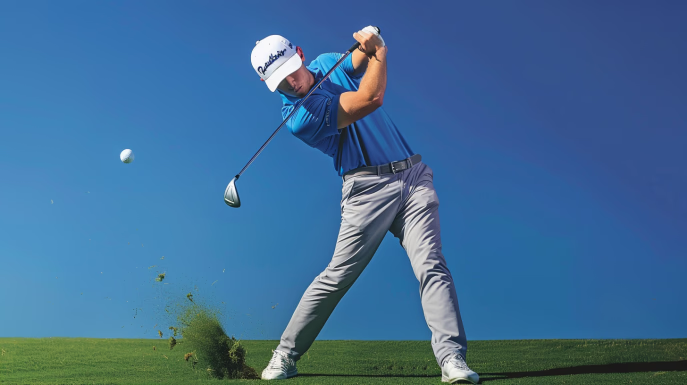Follow-Through Drills: Improve Your Golf Swing Technique

Source : pinnaclegolfpros copyright
Proper golf swing technique is crucial for consistent performance and control on the course. One of the most important aspects of the swing is the follow-through, as it directly impacts clubhead speed, balance, and overall swing mechanics. This comprehensive guide will explore a variety of follow-through drills designed to help golfers improve their swing technique, power generation, and scoring potential.
The follow-through is a critical component of the golf swing, and mastering this phase can unlock a wealth of benefits for players of all skill levels. By focusing on the intricacies of the follow-through, golfers can develop a more consistent, fluid, and repeatable swing, leading to improved ball striking, distance control, and overall scoring performance.
Key Takeaways
- The follow-through directly impacts clubhead speed, balance, and overall swing mechanics.
- Mastering the follow-through can unlock improved consistency, power, and scoring potential.
- Follow-through drills can help golfers develop a more fluid, repeatable swing.
- Proper technique in the follow-through phase is crucial for consistent ball striking and distance control.
- Incorporating follow-through drills into your practice routine can lead to long-term swing improvements.
The Importance of the Follow-Through

The follow-through is a critical component of the golf swing, as it directly impacts clubhead speed, balance, and overall swing consistency. A proper follow-through allows golfers to generate maximum power, maintain control and accuracy, and develop a more fluid, repeatable swing. This section will explore the key benefits of focusing on the follow-through, including strategies for increasing clubhead speed and maintaining optimal posture and balance throughout the swing.
Generating Clubhead Speed
The follow-through is a crucial phase in the golf swing for maximizing clubhead speed. By extending the club fully and maintaining a balanced, fluid motion through the impact zone and beyond, golfers can unlock greater power and distance. Techniques such as body rotation, weight transfer, and arm extension during the follow-through are essential for unleashing the club’s full kinetic energy and delivering the ball with increased velocity.
Maintaining Posture and Balance
A well-executed follow-through is also vital for maintaining proper posture and balance throughout the swing. By focusing on extending the club, keeping the head still, and distributing weight evenly during the follow-through, golfers can develop a more stable, repeatable swing that promotes consistent ball striking and improved accuracy. Drills targeting body alignment, weight shift, and full-body integration can help golfers master the balance and control needed for a powerful, yet controlled follow-through.
Mastering the Swing Finish Position
Achieving a powerful, balanced swing finish is the hallmark of a consistent, high-performing golf swing. This section will explore the key elements of the swing finish, focusing on the importance of proper body rotation and extension, as well as the critical role of arm and wrist action in maintaining control and stability throughout the swing.
Body Rotation and Extension
The swing finish position is directly influenced by the golfer’s ability to achieve full body rotation and extension during the follow-through. By ensuring a comprehensive turn of the hips, shoulders, and core, golfers can generate maximum clubhead speed, power, and balance in their swing. Mastering this kinetic sequence, from the backswing through the finish, is essential for developing a repeatable swing path and weight transfer throughout the entire motion.
Incorporating extension drills and focusing on maintaining posture maintenance during the follow-through can help golfers cultivate the necessary flexibility and muscle engagement to achieve a balanced, powerful finish position. By optimizing their kinetic chain and swing fluidity, golfers can unlock increased distance and control on the course.
Arm and Wrist Action
In addition to the critical role of the lower body, the arm positioning and wrist action during the follow-through also play a significant part in maintaining swing consistency and control. Proper grip stability and release techniques are essential for ensuring a smooth, coordinated transition from the backswing to the follow-through.
Golfers who focus on developing a controlled, fluid release of the clubhead can achieve greater clubhead speed and power generation while maintaining balance and precision throughout the swing. By incorporating targeted full swing drills and wrist action exercises, golfers can build the necessary muscle memory and coordination to execute a consistent, powerful swing finish.
| Key Swing Finish Techniques | Benefits |
|---|---|
| Body Rotation and Extension |
|
| Arm and Wrist Action |
|
Weight Transfer and Swing Path

Proper weight transfer and swing path awareness are essential for generating consistent, powerful follow-throughs. This section will explore techniques for maintaining a balanced weight shift throughout the swing, as well as strategies for developing a more consistent swing plane.
Proper Weight Shift
Effective weight transfer is a key component of a well-executed golf swing. Golfers should focus on shifting their weight to their lead foot during the downswing, maintaining a balanced and stable base. This weight shift allows for increased hip rotation and a more powerful transfer of energy from the lower body to the upper body, resulting in greater clubhead speed and ball striking consistency.
Swing Plane Awareness
Developing a consistent swing plane is essential for achieving a smooth, repeatable follow-through. Golfers should strive to keep their swing path on a shallow, inside-to-out trajectory, with the clubhead traveling along a path that is slightly steeper than the target line. This swing plane awareness helps to promote a more balanced and controlled follow-through, allowing for better clubhead control and shot shaping capabilities.
| Technique | Benefits |
|---|---|
| Proper Weight Shift |
|
| Consistent Swing Plane |
|
By optimizing their weight transfer and swing path, golfers can maximize clubhead speed, control, and overall swing efficiency, leading to improved ball striking, distance, and scoring potential.
Follow-Through Drills for Consistency

Developing a consistent follow-through is crucial for improving overall swing mechanics and shot consistency. This section will introduce a variety of drills and techniques focused on enhancing the release, grip stability, and timing/rhythm aspects of the follow-through. Golfers will learn how to implement these drills into their practice routines to build muscle memory, increase clubhead speed, and maintain control throughout the swing.
Release Techniques
Proper release of the clubhead during the follow-through is essential for generating power and consistency. Golfers can explore drills that emphasize a smooth, controlled release, such as the arm swing drill and the delayed release drill. These exercises will help develop a more fluid and efficient release, leading to improved ball striking and increased clubhead speed.
Grip Stability
Maintaining a stable grip throughout the swing, particularly during the follow-through, is crucial for consistency and control. Golfers can practice drills that focus on grip pressure and wrist action, such as the grip pressure drill and the wrist hinge drill. These techniques will help golfers develop a more consistent and repeatable swing by ensuring a stable grip and efficient wrist action during the follow-through.
Timing and Rhythm
The timing and rhythm of the follow-through are critical for a smooth, consistent swing. Golfers can incorporate drills that emphasize the importance of swing tempo and rhythm, such as the metronome drill and the slow-motion swing drill. These exercises will help golfers develop a more consistent, fluid swing and improve their overall timing and rhythm, ultimately leading to greater control and consistency on the golf course.
Generating Power Through the Follow-Through
At the heart of an efficient, powerful golf swing lies the importance of the follow-through. Harnessing the full kinetic chain and transferring energy from the backswing to the follow-through is crucial for unlocking increased clubhead speed, distance, and launch conditions. This section will explore techniques and drills that golfers can utilize to maximize their body rotation, hip and shoulder turn, and maintain a balanced, extended finish position.
Proper weight transfer and swing path awareness are essential for generating optimal power through the follow-through. Golfers must learn to maintain a fluid, balanced swing that allows them to seamlessly transfer weight and rotate their hips and shoulders, creating a powerful, consistent swing sequence. By focusing on these key elements, players can unlock their true power generation potential and consistently deliver the clubhead to the ball with authority.
Complementing the physical aspects of the follow-through, visualization practices and mental focus play a crucial role in enhancing swing fluidity and control. Golfers who can vividly picture their ideal finish position and maintain a centered, targeted mindset throughout the swing are more likely to achieve the desired ball striking and distance results.
| Follow-Through Fundamentals | Drills and Techniques |
|---|---|
| Body Rotation | Full Swing Drills, Coordination Exercises, Swing Rhythm Practices |
| Hip and Shoulder Turn | Hip Rotation Drills, Shoulder Turn Exercises, Kinetic Chain Integration |
| Balanced Finish Position | Extension Drills, Posture Maintenance, Balance Improvement Practices |
| Weight Transfer and Swing Path | Weight Shift Drills, Swing Path Awareness Exercises, Timing Improvements |
| Visualization and Mental Focus | Swing Checkpoints, Mindfulness Techniques, Repetition Routines |
By mastering the fundamentals of the follow-through and incorporating the appropriate drills and techniques, golfers can unlock their full power generation potential and consistently deliver powerful, controlled shots that leave them in prime position on the golf course.
Flexibility and Mobility Exercises

Achieving a consistent and powerful golf swing starts with prioritizing physical flexibility and mobility. By incorporating targeted exercises and drills into their training regimen, golfers can enhance their body’s range of motion, stability, and overall kinetic chain efficiency – all of which are crucial for optimizing the follow-through phase of the swing.
Core Strength and Stability
A strong and stable core is the foundation for an efficient golf swing. Golfers should focus on exercises that challenge their abdominal, back, and hip muscles, improving their ability to maintain proper posture, balance, and rotational control throughout the swing. Planks, dead bugs, and stability ball exercises are excellent choices for building core strength and enhancing swing fluidity.
Joint Mobility Drills
Improving joint mobility, particularly in the hips, shoulders, and wrists, can significantly enhance a golfer’s ability to generate power and maintain proper swing mechanics during the follow-through. Implementing dynamic stretches, foam rolling, and joint-specific mobility drills can help increase range of motion, reduce the risk of injury, and unlock additional clubhead speed and distance.
| Exercise | Description | Benefits |
|---|---|---|
| Hip Circles | Stand with feet shoulder-width apart, engage your core, and make large circles with your hips in both directions. | Improves hip mobility and rotation, essential for an efficient follow-through. |
| Shoulder Dislocates | Hold a golf club or broomstick behind your back and gently move it up and down, keeping your arms straight. | Enhances shoulder flexibility and range of motion, enabling a fuller, more powerful swing finish. |
| Wrist Circles | Extend your arms in front of you, palms facing down, and make circular motions with your wrists in both directions. | Increases wrist mobility and stability, crucial for a consistent release and follow-through. |
By incorporating these flexibility and mobility exercises into their practice routines, golfers can unlock the full potential of their follow-through, leading to increased clubhead speed, power generation, and overall swing consistency.
Follow-Through Drills
Developing a consistent and powerful follow-through is essential for golfers looking to improve their overall swing mechanics and shot consistency. This section will present a comprehensive collection of drills designed to help players enhance various aspects of the follow-through, including body rotation, weight transfer, arm and wrist action, and overall swing fluidity.
One of the foundational drills is the Extension Drill, which focuses on maintaining a full, balanced finish position. Golfers begin by setting up to the ball as usual, but instead of completing a full swing, they focus on extending their arms and rotating their body fully through the target, holding the finish for a few seconds. This helps reinforce proper weight transfer, shoulder turn, and a stable, centered follow-through.
Another valuable exercise is the Wrist Hinge Drill, which targets the critical role of wrist action in the follow-through. Golfers start by taking a practice swing, focusing on hinging their wrists fully during the backswing and maintaining that hinge through the follow-through. This drill enhances grip stability, release techniques, and the overall kinetic chain of the swing.
| Drill | Focus | Key Benefits |
|---|---|---|
| Extension Drill | Balanced Finish Position | Improves weight transfer, shoulder turn, and swing fluidity |
| Wrist Hinge Drill | Wrist Action | Enhances grip stability, release techniques, and kinetic chain |
| Body Rotation Drill | Coordinated Body Movement | Develops consistent swing path, clubhead control, and power generation |
| Acceleration Drill | Clubhead Speed | Increases distance, launch conditions, and overall swing efficiency |
| Repetition Routine | Muscle Memory | Builds consistency, timing, and confidence in the follow-through |
The Body Rotation Drill emphasizes the importance of coordinated body movement throughout the swing, with a focus on maintaining a balanced, engaged core and proper hip and shoulder turn during the follow-through. This drill helps players develop a more consistent swing path, improve clubhead control, and unlock greater power generation.
For golfers seeking to increase clubhead speed and optimize launch conditions, the Acceleration Drill is particularly beneficial. This drill involves taking full swings while focusing on accelerating the clubhead through the impact zone and maintaining a strong, extended finish position. By harnessing the kinetic chain and maximizing energy transfer, golfers can see significant improvements in distance and overall swing efficiency.
Finally, the Repetition Routine is a crucial practice technique for building muscle memory and developing a consistent follow-through. By dedicating a portion of each practice session to repeated, focused swings with an emphasis on the follow-through, golfers can enhance their timing, rhythm, and confidence in executing a reliable, repeatable swing.
Incorporating these follow-through drills into your practice regimen can help you develop a more consistent, powerful, and balanced golf swing, ultimately leading to improved ball striking, distance control, and overall scoring potential on the course.
Visualization and Mental Focus
Achieving a consistent, powerful follow-through not only requires technical mastery but also a strong mental game. This section will explore the role of visualization and mental focus in developing a repeatable golf swing. By incorporating these mental strategies, golfers can enhance their swing mechanics, increase consistency, and ultimately improve their overall performance on the course.
Swing Checkpoints
Maintaining focus and awareness during the follow-through is crucial for maintaining control and balance. Golfers will learn to identify key swing checkpoints that serve as mental cues, helping them stay present and engaged throughout the entire motion. These checkpoints may include the position of the club, the alignment of the body, the weight shift, and the final finish position. By consistently referencing these checkpoints, golfers can build a more consistent, repeatable swing.
Mindfulness Techniques
In addition to swing checkpoints, golfers can also benefit from incorporating mindfulness techniques into their practice routines. This may include deep breathing exercises, visualization practices, and mental rehearsal of the perfect follow-through. By cultivating a state of present-moment awareness and mental focus, golfers can enhance their ability to maintain control, confidence, and concentration during the critical follow-through phase. These mindfulness techniques can help golfers develop a more fluid, automatic swing, ultimately leading to improved ball striking and scoring potential.
Swing Analysis and Feedback
Continuous feedback and swing analysis are essential for improving follow-through mechanics and overall swing performance. By leveraging advanced technologies and seeking expert guidance, golfers can identify areas for improvement and make targeted adjustments to develop a more consistent, powerful, and repeatable swing.
Video Analysis
Video analysis has become an invaluable tool for golfers looking to fine-tune their swing mechanics, including the critical follow-through phase. By reviewing slow-motion footage of their swing, players can pinpoint areas that require attention, such as body rotation, weight transfer, and arm and wrist action. This detailed feedback allows them to make small, incremental changes to their technique, leading to improved ball striking, consistency, and overall performance on the course.
Professional Coaching
While video analysis provides valuable insights, working with a knowledgeable golf coach can take a golfer’s swing development to the next level. Experienced instructors can use a combination of video, biomechanical analysis, and on-course observation to provide tailored feedback and drills focused on optimizing the follow-through. From enhancing body mechanics to refining timing and rhythm, professional coaching can help golfers unlock their full potential and achieve more consistent, powerful swings.
Conclusion
In conclusion, the follow-through is a critical component of the golf swing that deserves dedicated attention and practice. By incorporating the drills and techniques outlined in this comprehensive guide, golfers can develop a more consistent, powerful, and balanced swing, leading to improved ball striking, distance control, and overall scoring potential.
Remember, consistency and repetition are key when it comes to mastering the follow-through drills, swing finish, and achieving balance in swing. Golfers should focus on increasing their clubhead speed, optimizing body rotation and swing path, and perfecting their weight transfer to unlock the full potential of their follow-through.
Whether it’s practicing extension drills, maintaining proper posture and arm positioning, or honing their wrist action and grip stability, golfers who dedicate time to enhancing their release techniques and swing consistency will see significant improvements in their power generation and overall swing performance. By embracing the insights and full swing drills presented in this guide, golfers can embark on a journey of continuous muscle engagement, flexibility improvement, and kinetic chain optimization, ultimately achieving a more fluid, repeatable swing.
So, stay focused, trust the process, and enjoy the visualization practices and swing checkpoints that will help you refine your impact zone and acceleration drills, leading to greater control and precision on the golf course. With a commitment to backswing connection, target alignment, and cultivating the right mental focus, golfers can master the art of the follow-through and unlock their full potential through repetition routines, feedback correction, and timing improvements.
FAQ
What are the key benefits of focusing on the follow-through in golf?
The follow-through is a critical component of the golf swing, as it directly impacts clubhead speed, balance, and overall swing consistency. A proper follow-through allows golfers to generate maximum power, maintain control and accuracy, and develop a more fluid, repeatable swing.
How does the follow-through affect clubhead speed and power generation?
The follow-through is crucial for generating clubhead speed and maximizing power. By maintaining a balanced, extended finish position, golfers can harness the full kinetic chain and transfer energy from the backswing through the follow-through, unlocking increased distance and launch conditions.
What are some key aspects of the swing finish position that golfers should focus on?
Mastering the swing finish position is crucial for developing a consistent, repeatable golf swing. Golfers should focus on proper body rotation and extension during the follow-through, as well as the role of arm and wrist action in maintaining control and stability throughout the swing.
How can golfers improve their weight transfer and swing path awareness during the follow-through?
Proper weight transfer and swing path awareness are essential for generating consistent, powerful follow-throughs. Golfers should focus on maintaining a balanced weight shift throughout the swing, as well as developing a more consistent swing plane, to optimize clubhead speed, control, and overall swing efficiency.
What are some drills and techniques that can help golfers develop a more consistent follow-through?
Developing a consistent follow-through is crucial for improving overall swing mechanics and shot consistency. Golfers can implement drills focused on enhancing the release, grip stability, and timing/rhythm aspects of the follow-through to build muscle memory, increase clubhead speed, and maintain control throughout the swing.
How can flexibility and mobility exercises benefit the golf follow-through?
Flexibility and mobility play a crucial role in developing an efficient, repeatable golf swing, particularly in the follow-through. Golfers can improve core strength and stability, as well as overall joint mobility, to enhance swing fluidity, power generation, and injury prevention during the follow-through phase.
What are some key visualization and mental focus techniques that can help golfers improve their follow-through?
Achieving a consistent, powerful follow-through also requires a strong mental game. Golfers can learn about key swing checkpoints and mindfulness techniques that can help them maintain concentration, confidence, and control throughout the follow-through phase, leading to improved swing mechanics and increased consistency on the golf course.
How can golfers utilize swing analysis and professional coaching to optimize their follow-through mechanics?
Continuous feedback and swing analysis are essential for improving follow-through mechanics and overall swing performance. Golfers can leverage video analysis and seek professional coaching to identify areas for improvement and make targeted adjustments to develop a more consistent, powerful, and repeatable swing.

